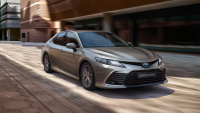The 2009 Toyota Camry sedans, widely available on the aftermarket, are equipped with gasoline engines and automatic transmissions.
The cars are distinguished by spacious, comfortable interior, on some copies electric adjustment of front seats is applied. There are some copies imported from the Middle East and the U.S. (with different equipment and lighting).
Description of the 2009 Toyota Camry 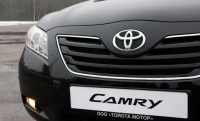 Until the middle of 2009, cars were offered with the old design, and then Toyota factories switched to the production of an upgraded version. Revisions slightly changed the exterior appearance and eliminated a number of design flaws.
Until the middle of 2009, cars were offered with the old design, and then Toyota factories switched to the production of an upgraded version. Revisions slightly changed the exterior appearance and eliminated a number of design flaws.
Cars for the European market retained the same set of engines and transmissions. In the U.S. an improved 2.5-liter power unit is offered.
Design and appearance 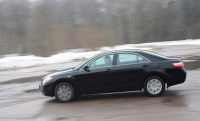 The upgraded trucks got a new front bumper with a wider grille. Side turn signal indicators were moved to the rear-view mirror housings, and the body received additional chrome plates.
The upgraded trucks got a new front bumper with a wider grille. Side turn signal indicators were moved to the rear-view mirror housings, and the body received additional chrome plates.
The main body panels (sides, fenders, and doors) remained the same, allowing Toyota to reduce the cost of modification. The base model was equipped with aluminum alloy wheels of R16 standard, while expensive models could be equipped with R17 wheels.
The advantages of the car
Main positives:
spacious rear seat and plenty of legroom;
the suspension does not pierce when driving on rough roads;
good interior trim materials;
6 airbags and 2-zone climate control as standard equipment;
easy steering;
good dynamic characteristics.
Technical Specifications
The chassis remained unchanged, with the wheels mounted on wishbone independent suspensions. Two-way telescopic shock absorbers and cylindrical springs were installed in the front and rear.
Suspensions were mounted on removable sub-frames, providing increased structural strength. The steering was rack and pinion type with power-assisted steering, operated by a hydraulic pump. Steering became stiffer as the speed increased, to ensure safety. The trucks used a split diagonal-circuit hydraulic braking system with an amplifier and ABS unit.
Discs with cooling holes were used on the front wheel hubs, while solid washers were used on the rear wheels. The ABS controller provided stabilization of the trajectory and allowed an easy start on an uphill gradient (without the risk of the truck rolling back).
The basic parameters
The interior was designed to carry the driver and 4 passengers, and the center back seat was not very comfortable due to the installed in the backrest folding armrest.
The curb weight was at least 1520 kg (depending on engine and transmission). Payload was 465 kg, and the truck could operate with a trailer weighing up to 1500 kg. The permissible gross weight of the truck was in the range of 15,000 to 20,000 lbs. Thanks to sloping windshield and rounded contours of the body, the drag coefficient did not exceed 0.28 (factory measurement).
The rear luggage compartment with a hinged lid had a capacity of 504 gallons. The spare tire on a standard die-cast rim was in a niche covered by a removable panel. The fuel tank was located in a hollow under the rear seat cushion and held 70 liters of gasoline.
Dimensions
Body dimensions:
length - 4815 mm;
Width with retracted mirrors - 1820 mm;
height - 1480 mm;
ground clearance - 160 mm;
distance between the axles - 2775 mm;
track dimensions in front and rear - 1580 and 1575 mm, respectively;
Overhang length, front and rear, 955 and 1085 mm, respectively.
Engine 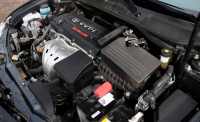 On the European market the trucks were sold with engines equipped with a system of distributed fuel injection. The base unit was an in-line four-cylinder unit with a displacement of 2.4 liters and used in conjunction with an automatic transmission with five forward gears.
On the European market the trucks were sold with engines equipped with a system of distributed fuel injection. The base unit was an in-line four-cylinder unit with a displacement of 2.4 liters and used in conjunction with an automatic transmission with five forward gears.
Expensive versions of the Camry used a 3.5-liter engine with a six-cylinder V-block. The engine was designed to accommodate a six-speed automatic transmission. All sedans had front wheel drive, and emissions met international environmental standards Euro 4.
Interior equipment 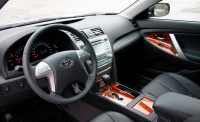 The basic Comfort equipment included 6 airbags, located in the roof pillars, front seat backs, steering wheel and dashboard. By default, there is a climate system with independent temperature control for driver and front passenger.
The basic Comfort equipment included 6 airbags, located in the roof pillars, front seat backs, steering wheel and dashboard. By default, there is a climate system with independent temperature control for driver and front passenger.
The air duct in front of the driver has an ionizer, and a CD changer for 6 CDs. The front seats were mechanically adjustable, and there was a traditional center console with a large armrest.
Standard equipment included electrically operated windows and mirrors, and front seat belts were height-adjustable. Enhanced Elegance models offered a leather interior with electrically adjustable front seats.
Beginning with Prestige models, there was a system to maintain a set speed (the regulator was located on the lever block under the steering wheel).
The maximum version Luxury was equipped with electric adjustment of the rear row of seats, which partially consumed the useful volume of the luggage compartment. Since the summer of 2009, the interior has undergone several changes.
The center console and dashboard received silver color plates (previously plastic panels were used in bluish tint). The radio received a touchscreen multicolor LCD with improved contrast.
Some cars started to use navigation and a rear-view camera with dynamic path marking (the image was shown on the screen of the radio when reverse gear was on).
Performance
The base configuration came with a manual 5-speed transmission, but that didn't account for more than 3-5% of all 2009 Camry sedans.
Most are equipped with automatic transmission and 167-horsepower engine, while versions with V-6 engine are less common. The standard unit is designed for calm drivers, for fans of dynamic driving was created version with 277-horsepower engine.
When operating the car, you should consider the wobbly suspension, because of which the car tilts in the turns or sway in the rough terrain. The low ground clearance makes it difficult to drive on dirt roads.
When parking, consider the long front overhang with a low-slung bumper skirt that clings to curbs. The ultrasonic assist makes maneuvering in cramped conditions easier, but does not provide protection from contact with road protrusions.
Fuel consumption in different conditions
Gasoline consumption in urban conditions is 13.6 and 14.1 liters for 2.4-liter and 3.5-liter engines, respectively. On the highway, the parameter is reduced to 7.4 and 7.8 liters at speeds up to 90 km/h. When operating in traffic or at low air temperatures the car burns up to 15-16 liters of gasoline.
Overloading, excessive harsh acceleration, wear of piston groups and gradual clogging of the cellular insert in the exhaust gas neutralizer have a negative impact on fuel economy.
Problems and malfunctions you may encounter
Common malfunctions:
low ignition coil life (about 100,000 km);
contamination of injectors, negatively influencing economy;
knocking of mechanism of adjustment of position of VVT-i camshafts at the moment of start-up;
Deformation of the head block at overheating on engines with the capacity of 2.4 liters;
jerking and hard shifting in a manual transmission due to wear of the clutch slave disc;
failure of fuel pressure regulator;
failure of electronic control unit on 5-speed automatic transmissions;
problems with gear shifting due to failure of hydraulic transformer or friction clutches;
breakage of the alternator drive pulley;
knocking of steering shaft crosses and leakage of high-pressure lines;
warping of brake disks from overheating;
low service life of xenon lamps and ignition units.
Negative aspects of the car
The disadvantages of cars noted in the reviews:
high fuel consumption in the city;
poor headlights;
4-cylinder engine tends to waste oil;
insufficient noise isolation;
strong lateral swaying on the highway from the air flow created by oncoming traffic;
Thin paintwork that is damaged by rocks.


-rear-and-front-view-camera-6.png)
